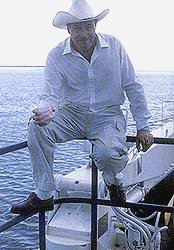Licensed to Thrill: An Interview with John Glen
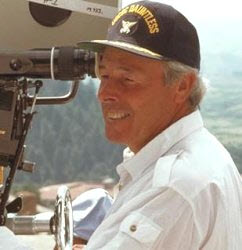 Here’s a secret: James Bond had help. Lots of help, in fact. Each time he leapt out of an airplane without a parachute, dodged bullets on a ski slope, or seduced some long-legged vixen, someone was always hovering nearby to make sure everything went off without a hitch. Quite often, that man was John Glen.
Here’s a secret: James Bond had help. Lots of help, in fact. Each time he leapt out of an airplane without a parachute, dodged bullets on a ski slope, or seduced some long-legged vixen, someone was always hovering nearby to make sure everything went off without a hitch. Quite often, that man was John Glen.
After editing action television shows for many years, Glen flew to Switzerland in 1969 to film the famous bobsled run sequence of On Her Majesty’s Secret Service. Glen “bonded” to the series right away and went on to do second-unit directing and editing chores on Moonraker and The Spy Who Loved Me. A crack action and stunt director, Glen was behind the camera when Rick Sylvester launched himself off Asgard Peak in the pre-title sequence to the latter film.
Glen called the shots for the first time with 1981’s For Your Eyes Only. He went on to direct all five Bond films of that decade. His work includes some of the most action-packed films the series has ever known. Hair-raising sequences like ski chase in For Your Eyes Only, the Golden Gate sequence in A View to a Kill, and the climax in and above Afghanistan for The Living Daylights set the tone for the super-action, Die Hard-style movies that have come into vogue since. The current batch of summer action blockbusters owe Glen a debt of gratitude.
But Man does not live by Bond alone. As such, Glen has done notable work outside the 007 genre. He edited the acclaimed Murphy’s War which Leonard Maltin praised for its “well-staged [and] gripping action sequences.” Other editing credits include Gold, Shout at the Devil, and The Sea Wolves. (All three with Roger Moore; the first two with director Peter Hunt.) And Glen was in charge of the second-unit for Superman: The Movie – one of the biggest blockbusters of 1978.
Recently, John Glen discussed his career with Mr. Kiss Kiss Bang Bang.
Prior to being hired as second-unit director for On Her Majesty’s Secret Service, how much of a Bondphile were you? Had you read the books or seen the films?
Yes. The books were so good – like “Goldfinger” and “From Russia With Love” – it was almost as though they were written for the screen. And, like everyone else of my generation, we were kids and we used to go and watch these films. As far as I was concerned, it was like a dream come true when I began to work on them.
Did director Peter Hunt really tell you to “just shoot everything and you’ll be fine”?
I don’t remember him saying that exactly, but I think the whole point of my being appointed was that they had very little material from the previous crews that were working. This was in part due to the unusually mild winter that they were experiencing in Switzerland in 1969. They started very early in October or something, and the snows didn’t arrive until very late. When they did arrive, and you’ve been sitting around for two or three months waiting for the weather, you’ve got to be very ready to get cracking or something happens up in mountains and you just can’t move anymore. So they were a little unfortunate that they couldn’t get the weather they needed.
In the film business, results count. If the film isn’t coming in then something has to be done drastically and that’s why I was appointed. Initially I was appointed to direct the bob run sequence, and I did that in record time. Because of that they then gave me the rest of the second-unit sequences to direct – apart from the stock car sequences that had been done by the previous unit.
How long did it take to shoot the bobsled run sequence from start to finish?
It took about three weeks.
With Bond films, who decides how the story’s going to go? Can the director expect to have a lot of input into the script?
Generally, the actual theme of the story – what the story is going to be about – is something which is hashed out with the writers and Cubby and whoever. Then at that stage, when they have kind of a treatment, then I’m usually invited in on the proceedings – in fact, I’m probably not employed until that point. Then I come in and we start to go through it and start to make changes.
Now, during this period, sometimes – as it happened on Octopussy, for instance – the original story gets thrown out completely and we go with another story. So, to that extent, I was involved in the new story. But generally a treatment already exists. Whether or not that treatment will be the final treatment was quite often changed. It’s very seldom that the original treatment is pursued all the way through pre-production. For example, some world event might happen which would cause us to change the story because we like to be up to the moment.
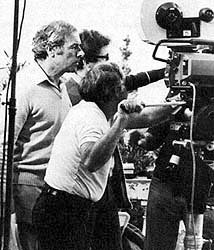 What happened with Octopussy?
What happened with Octopussy?
It was just going in the wrong direction, I think. George McDonald Frasier was the writer and we went out to Hollywood together and we worked on the story. It was going in a certain direction, and I was back in England doing my prep and Cubby called and said “I don’t like the story. We’ve got another story. Come on out.” They changed the writer to Dick Maibaum and Michael Wilson, and we went back and started all afresh.
On page 18 of Sally Hibbin’s book “The Making of Licence to Kill,” you are quoted as saying “you spend the money on what makes Bond Bond – the rest we can shoot like television.” This has caused a minor uproar among fans ever since. Exactly what did you mean?
I don’t recollect saying it. I’m on record as saying that? Let me hear it again [the quote is read to him again].
[pauses] Well, I think probably what I was trying to say was that the actual dialogue scenes can be of immense value in the film if the acting is superb and the dialogue is superb. But generally the Bond films are action-oriented films so one has to get one’s priorities straight. No one would go see a Bond film for the dialogue necessarily, although there are some very nice moments – particularly the romance scenes and the love scenes.
Honestly, I don’t remember ever saying that quote, and I don’t really think that’s true. Sometimes, you know, one gets the wrong end of the stick when doing interviews. I worked on television prior to that, and what I may have said was that the dialogue scenes are easy because the actors are allowed to run for two minutes and, for a director, it’s very easy.
Action is more difficult because it’s more fragmented, you have to break it down into very small components. It’s very shooting intense. You have to have many, many set-ups – far more than in a dialogue scene. I think that’s probably what I was saying.
You mentioned that action sequences are more fragmented. Who strings them all together?
The director certainly does. Looking back on it, I should have kept all my little sketches I used to make. I used to make very childlike sketches of each cut in the sequence.
Like storyboards?
Yes, absolutely. Except I always used to think that no one else could understand these storyboards except myself. In fact, it turns out that the very people involved in the sequence couldn’t recognize them.
As the years went by, I improved on them, I became a lot quicker – that was the beauty of my storyboards, I could do them very, very quickly. Quite often, with the Bond movies, I would then employ a storyboard artist who would take my sketches and produce a professional storyboard. The advantage of this, as far as the editor was concerned, was that there was a cutting guide for how the sequence would come together. Quite amazingly, the sketches and storyboard were very, very accurate.
Who dreams it all up? Take the Eiffel Tower sequence in A View to a Kill, for instance. Who decided that the taxi was going to be jumped onto a bus, sliced in half, lobotomized by a cross bar, then driven down a staircase?
That was Remy Julienne and myself. We got together, and we decided what was possible to do with this situation. Then I went away and I wrote it all down and then Remy separately came to me with a couple of ideas and that’s how progressed through the sequence. It was all a consultation between Remy Julienne and me.
Remy is one of the foremost stuntmen in the world – or he certainly was at that time – and I’d previously worked with him on The Italian Job. I remembered what he did there with the little Minis and so forth. He’s an incredible artist really – an artist with cars. So I listened very closely to what Remy said he could do. Sometimes he amazed me with what he could do.
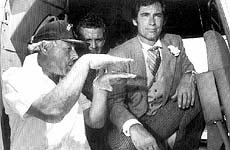 Aside from 007 movies, what films have you admired for their action sequences?
Aside from 007 movies, what films have you admired for their action sequences?
Well, I think the old Hitchcock films. What I used to admire about the Hitchcock films was his sense of humor – the way he used to take a trite situation sometimes and just with very skillful use of humor he would make the scene memorable. Funny little things like the chap coming out of a pub trying to cross the road and the three chase cars come through the village and, in the end, he gives up and goes back into the pub. Things like that were so typical of Hitchcock and he always used to get them in his films. Particularly if he had a situation which he obviously initially didn’t like. In those days in Hollywood, you couldn’t change the script. They were sacrosanct, you signed off that you would shoot the script and you don’t get the freedom in those days that you get today.
Of the five films you directed, what sequence came off best on the screen?
Every film’s got memorable action sequences. I think the truck sequence in Licence to Kill was very good – the final action sequence at the end of the movie. The car chase in the vineyards in For Your Eyes Only was a very funny scene and very exciting. I think the pre-title sequence in Octopussy with the little jet is, to my mind, probably one of the best sequences.
In A View to a Kill – the scene in San Francisco with the airship – if you really examine that scene it’s a fantastic scene. The conception, the application, the difficulty of shooting on the Golden Gate bridge – the logistics alone are amazing when you examine what we achieved with that.
Were you actually on top of the Golden Gate?
[laughs] I actually stood on the very top. There’s a two-man elevator that goes up the main support and I had the privilege of squeezing into that and going to the top – it’s like going up in a coffin. You step out and you’re on top of the world. It’s the most incredible sight. And the tubes that contain all the wires up there are quite huge – like six or eight feet in diameter – so you can walk on the top of them quite safely because they’re so large.
There were a lot of minor animal scenes in your films – the tiger and the camel in Octopussy, the birds that startled Bond in For Your Eyes Only, the cat in A View to a Kill, and many others. Was this written into the script just or added on the fly?
It was written into the script. I always used to try to get animals into our films because I just love animals and I just think they’re so wonderful. They’re very, very good on take one. They’re brighter than we are, and if they experience something with all the lights and all that on a film set, they usually don’t want to repeat it. They’re reluctant to do a take two.
I’m thinking now of On Her Majesty’s Secret Service. We were fighting the light in the scene when George Lazenby comes flying out of the bob run and he lands in the snow and then up comes trotting the St. Bernard with the Hennessy barrel around his neck. Well, we had to put the dog in a helicopter and take him to the other side of the mountain because there was two hours more sunshine there. I told George “For goodness sake, get your lines right because this dog’s only going to do this once, I’m sure.” Having transported the dog, we set the cameras up, called “Action!” and, sure, enough, the dog came in, rolled on his back in the snow, threw his paws in the air, and George said – perfectly – “Never mind about that, fetch the brandy.” It was quite incredible that it worked on take one absolutely perfectly.
The tiger, for instance – there’s a line in Octopussy where Roger Moore says “Sit!” Dr. Barbara Woodhouse was making a big hit in American on television with her lectures about how to treat dogs. The line came directly from her fame and topicality in America at the time.
 In cinema today, music and action are almost inseparable. How did you work with the composers? Did you tell them “I want a crescendo here and cymbal clash here”?
In cinema today, music and action are almost inseparable. How did you work with the composers? Did you tell them “I want a crescendo here and cymbal clash here”?
No. Bill Conti, John Barry – they’re such superb musicians that that’s last thing you’d say. You don’t use music in the Bond movies quite that way. You use music sometimes to underline a scary moment because you want to create a shock. You certainly use music to help you with that if you can’t use a sound effect – sometimes you just use the music as a sound effect. In this case you make a special point of asking the musician to help you with that, or he may even augment what you’re putting in on the sound. But generally this business of sort of pointing things, you don’t really do that in the modern world.
I think things have changed a bit over the years with music. It’s more creating – what the music does is create a kind of an atmosphere. It creates suspense, and it adds to the excitement. So, you don’t point things out quite as much, but you work very closely with the musician. When you’re on the session sometimes, you go over to him and you say “I think so-and-so doesn’t quite work. We need to do something else.”
For instance, on the chase through the vineyards in For Your Eyes Only, the first time I heard the score for the scene, [Bill] Conti had put musical horns and things into the score. So I called him aside and I said “Bill, I think that’s quite wrong for this movie. We’ve got to treat the action very seriously even though it’s funny. We’ve got to let the humor come out of it naturally, out of the drama and the suspense.” He thought about for a minute and said “Yeah, John, I understand exactly what you mean.” He went back to his score and made a few changes and all the horns disappeared.
So, we do work very closely with the composers, and we also use temporary scores. When we’re building the sequence in the cutting room we’ll put a piece of music in from another Bond movie. John Barry’s work – for instance – he’s a legend. His music is so much Bond. And Marvin Hamlisch did a wonderful score in The Spy Who Loved Me – but he was still in awe of John Barry.
Of the films you’ve worked on, which of the musical scores did you appreciate the most?
I used to be a film editor so I’ve been working with composers really all my working life. The first film I directed – For Your Eyes Only – I thought Bill Conti did a wonderful job. I think that John Barry has it. He’s the originator, if you like, of the Bond scores. He has a certain talent which is the hallmark of the Bond movies. Overall, Barry’s done some fantastic work. Marvin Hamlisch, his song “Nobody Does it Better” was an absolute inspiration. I think he is absolutely incredible. That was one of the greatest songs in the Bond movies, I think.
Is there an obligation to the “Bond mythos” that a director assumes? Are there specific differences between directing Bond films and directing everything else?
[laughs] Oh, absolutely. Bond movies have a style all their own. They’re kind of like a strip cartoon. They have what I always call “broad strokes.” Cubby would always say “where are the bumps?” when he reads the script. What he means is, where are the high points? The audience won’t tolerate too much chat until you get a bit of action again, so there’s a kind of a formula.
I think that Peter Hunt, who edited the early Bonds, created a whole new style of editing. Sean Connery would sort of turn his head to go for the door and the next moment the door would open and he would come out. This was completely new and it was like an abbreviated form of filmmaking. It was more like a strip cartoon. In other words, you got rid of all the boring stuff in life, like walking from one place to another – you just gave an indication.
For instance, when Bond was swimming to the refinery in the teaser to Goldfinger, there’s a duck going across the lake. Bond steps out and he’s got a duck on his head. He pulls off a rubber mask and he’s standing their in an immaculate dinner suit and plucks up a carnation and puts it in his lapel. I think that sums up Bond. I think that’s the style.
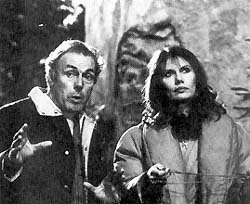 So you simply cut out all the mundane parts of a scene?
So you simply cut out all the mundane parts of a scene?
Exactly, yes. If it’s boring, you take it out. That’s exactly how the style was invented.
Second-guess Martin Campbell for me. What did you think of GoldenEye and would you have done anything differently?
Obviously, there are things that one would do differently. I thought it was pretty good effort – it had all the ingredients, it had some great action, Pierce was wonderful. I think it worked very well. It’d been five or six years since the last Bond and it needed to be good. From the box office, he really did the trick.
What happened with Licence to Kill? Box office returns were disappointing despite an engaging story and a top-notch performance from Timothy Dalton.
The thing is that MGM was going through absolute turmoil at that point. We had, I think, three or four different people on publicity during the course of making it – they were changing every few weeks. So what happened was that they didn’t seem to put the effort into selling the picture. If you look at the way they sold GoldenEye, it was a huge campaign, and they did a great job and spent a lot of money on it. They spent a lot of money on Licence to Kill, but it didn’t seem to me to be sold as it should have been. I put that down to the fact that the studio was upside-down, heads were changing, people were switching jobs, and new people were coming in all the time. It was a very difficult period. Now it’s stabilized but at that time is was difficult.
Was jumping from Roger Moore to Timothy Dalton terribly disruptive to the series?
Dalton was more in the Connery mold so we had to tailor the scripts. Roger was so humorous, and we tended to make all these films verging on comedy. They were very light situations – that was done purposely. When Timothy came on the scene, we had a fine Shakespearean actor, but he probably didn’t have the humor that Roger had so we tailored the scripts accordingly. We made them slightly blacker or darker, in the sense that we wanted more dramatic situations. He was more ruthless and more of the original Bond and that was what we were trying to get back to.
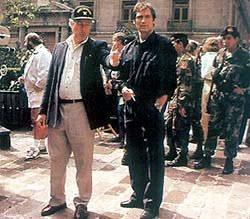 From a purely technical standpoint, would you set up the same scene differently for either of the two actors?
From a purely technical standpoint, would you set up the same scene differently for either of the two actors?
No, not really.
What’s the process of picking a new Bond? Who do think could step into the role now that Pierce has committed to no more than Bond 19?
Oh, I’ve no idea. By the time Pierce is done with it, there’ll be some new guy up there who doesn’t exist at the moment. Years ago, there was a possibility of Mel Gibson becoming Bond. Now he would have been a great Bond in his day, but he obviously wouldn’t be the right man now. But in his heyday, he would have been fantastic.
There’s always someone out there who could do it, it’s just a question of whether they will do it. I think if they’re already established like Mel is now – he’s such a wonderful director and actor – there would be no point in him doing Bond because he can’t prove anything – he doesn’t need to prove anything.
Pierce was actually perfect for the role of Bond. I tested him originally, but he was unable due to contractual commitments so he didn’t get the job then. But, looking back on it, I think that maybe that it was a good thing that he had to wait another six years, because he’s certainly filled out into the role now.
Tell me about the Maud Adams cameo in A View to a Kill.
We were shooting at Fisherman’s Wharf. Maud – who is a very good friend of ours – decided to come and visit us on the set with her boyfriend. I said to Maud “Come on, why don’t you become a crowd extra?” So she and her boyfriend walked through in the background, and by doing that she became the only woman to appear in three James Bond movies.
Rumor has it that you were screen testing James Brolin to replace Moore and that Maud was actually in San Francisco to test opposite him. True?
No. I did screen-test James Brolin, and he was extremely good. I think he would have gotten the job but they decided in the end that they didn’t want an American to play James Bond – that was the bottom line. We did the screen test actually in London and we brought a couple of stock actresses in to play Maud’s part.
I hear Roger Moore was quite the practical joker. Care to incriminate…I mean, elaborate?
Once, when we were shooting a scene with Desmond Llewelyn, Roger came to me and said “Let’s tell Desmond that the scene has changed and give him some new lines that he has to learn over lunch.” So we gave Desmond some ridiculous lines that no one probably could have remembered. I watched Desmond pace back and forth over lunch trying to memorize these lines until I couldn’t take it anymore, so I finally told him that Roger was trying to pull his leg.
But we turned it around and got back at Roger in the end. I wrote all the lines down on a clipboard and had a technician come up to Desmond and hand it to him during the scene. So, much to Roger’s amazement, Desmond was able to deliver them all perfectly.
Given the chance, would John Glen ever return?
Certainly I would. I’d be very honored to come back and direct another Bond movie. To me, it’s the perfect opportunity for my style of directing. I’ve just loved the films all my life, and I’ve seen so many changes in them and the characters that play in them. I wouldn’t have bones at all about coming back.
